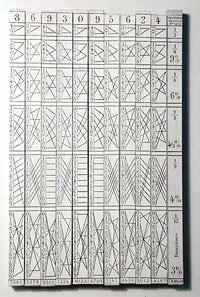 Up
Up
|
|

|

|
The Genaille-Lucas financial rods |
|
|
|
|
This set of eleven square rods, each about 17.5 cm long, would serve quite well to entertain a child: you could use them to build all sorts of structures. Nevertheless, it is not a toy, but a sophisticated and powerful calculation device. |
|
|
|
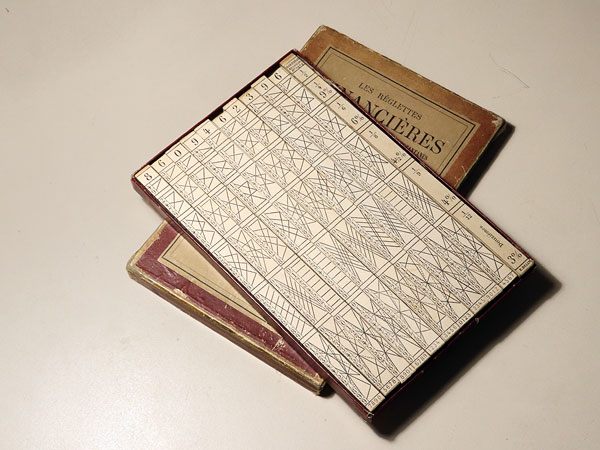 Click photo to enlarge |
|
|
|
These are Genaille-Lucas rods, which are an
improvement on the much older rods invented in 1617 by John Napier,
the Baron of Merchiston and the inventor of logarithms. Where
“Napier’s bones” could multiply and divide but required intermediate
steps of addition or subtraction to be performed by the user,
Genaille’s rods give the answer directly. These rods result from a collaboration between two talented Frenchmen. Henri Genaille (18??–1903) was a civil engineer employed by the state railroad company, who had already developed a number of mathematical devices; Édouard Lucas (1842–1891) was a mathematician who has left his mark on numbers theory (and, I was surprised to learn, has invented the famous “Towers of Hanoi” puzzle). Genaille had the idea for the principle underlying these rods while solving a problem posed by Lucas at a meeting of the French Association for the Advancement of Science; Lucas subsequently improved this idea, and the two proceeded to develop the rods into a commercial product. They also did their best at marketing, by presenting their invention to the said association and by describing it in a number of books. In his Recreations Mathematiques (Vol. 3), published posthumously in 1893, Lucas gives glowing praise to co-inventor and invention alike:
He then waxes lyrical about the benefits of the system, though he does get carried away -- there can’t have been many customers interested in multiplying 20-digit numbers!
Genaille and Lucas marketed four boxed sets. The first was for multiplication; the second, for division; the third, the one shown here, for financial calculations; and the last was a set of the classic Napier rods. The financial set is actually a special derivative of the division set, optimized for the single task of figuring daily interest for a given initial sum and annual interest rate. Here is the box: |
|
|
|
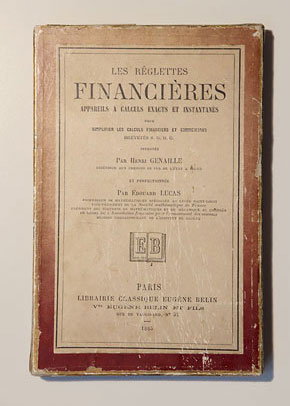
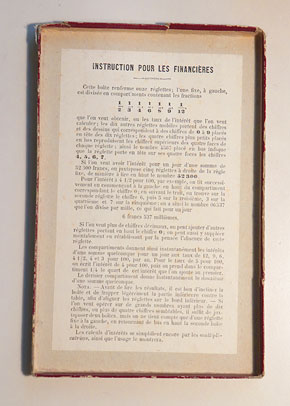 Click a photo to enlarge |
|
|
|
The box contains ten four-sided rods, each with a digit at the top that is used to assemble the number to be divided (in the financial scenario, the initial capital) and a one-sided index rod marked with annual percentage rates. To help identify the faces of the rods without turning them over, each face has at the bottom the four digits represented on this rod. |
|
|
|
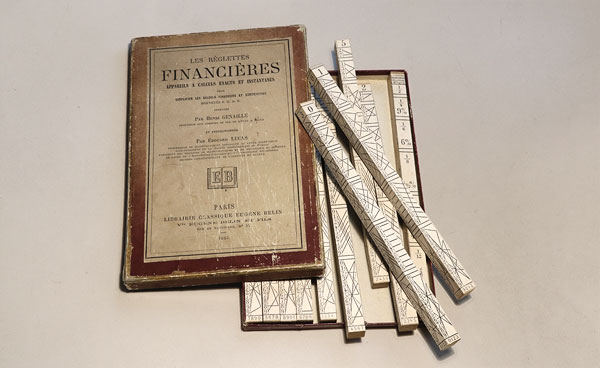 Click photo to enlarge |
|
|
|
Instructions for using the set are on the
inside of the box’s lid; you can see them, with my English
translation,
here.
Although comprehensive, they suffer from the lack of illustrations,
which I correct with the example below. So -- imagine that you’re a millionaire, and you’ve invested $2,095,425 at an annual return rate of 9%. What is the daily interest? To find out, you assemble 7 rods to represent your initial investment (as the digits at the top), and add the index rod at the right, as in this photo. You then focus on the row marked 9% on the index rod. You start at the leftmost rod, noting the top digit on it, which is 0. You now follow the lines from rod to rod, adding digits as you go: 0–5–2–3–8–5–6. And this is your result for the daily interest: $523.856. Lucas was quite right in likening the process to “following a path through a labyrinth, by means of indicator arrows on posts placed at the crossroads”; and he was right that “we learn to use these rods in a minute at most”. What’s more, the actual calculation is pretty much “exact and instantaneous”, as stated on the box -- just compare it to long division with pencil and paper! |
|
|
|
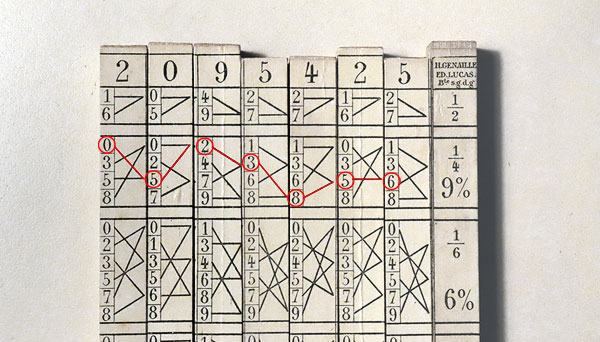 Click photo to enlarge |
|
|
|
You will note that the calculation in the example is actually a division by 4, which is why the index rod says 1/4 above the 9%. In fact, these rods allow division by 2, 4, 6, 8, 9 and 12 (though not 3, as erroneously stated in the instructions in the lid). The regular division rods cover all the integer divisors from 2 to 9, and this financial set covers a subset of them plus the 12. The financial connection is that the daily interest at 9% annual interest can be derived by dividing the initial sum (given in thousands) by 4; at 6%, by 6; at 4 1/2%, by 8; and so on. This is an approximation that assumes no compound interest and a business year of 360 days, which is evidently what French businesses were assuming at the time. You can check the math: it works. |
|
|
|
“But, you will say, the products are only obtained by a single number; if one could have immediately the products by the numbers of two, three, four digits! We have foreseen the case, and I will show you another arrangement, a little larger, of the rods, but with other designs. With these, but by sliding movements parallel to the fixed rod, we can obtain all the products of ten digits by ten digits. Thus the principle is found; but the operation is still rather painful, rather delicate; however we hope to shortly show you a calculating machine, giving the products of two ten-digit numbers; this machine will be really popular, because the price will not exceed 20 fr”. It is unfortunate that soon after writing
these words Mr. Lucas died, at the age of 49, taking that wonderful
plan to his grave. |
|
|
|
Exhibit provenance: Purchased from a fellow collector at an IM meeting. More info: |
|
|
|
|
|
|
|
Home | HOC | Fractals | Miscellany | About | Contact Copyright © 2020 N. Zeldes. All rights reserved. |
|
